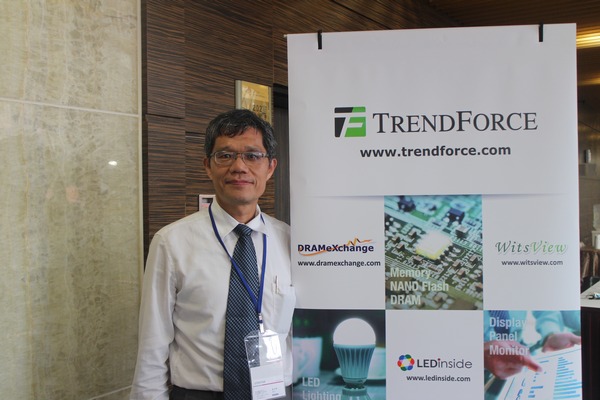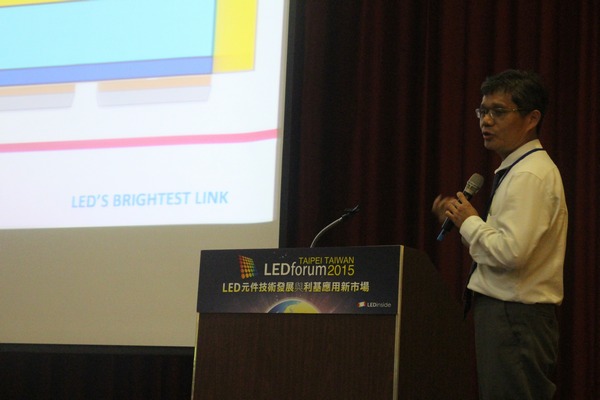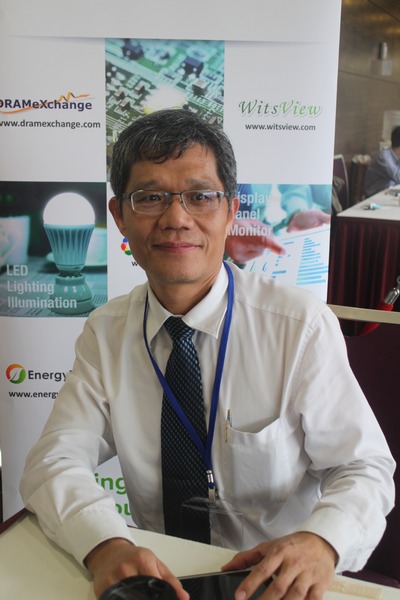Left bleeding from price wars over the past few years, LED manufacturers are seeking alternative markets and restructuring business strategies. Epistar for instance is looking into niche markets including GaN power devices and specialized lighting, said Carson Hsieh,Vice President, R&D Center,Epistar during his presentation at LEDforum 2015, which took place recently at Room 201, National Taiwan University Hospital International Convention Center, Taipei, Taiwan.
To cope with dwindling gross profits from the lighting market sector and a saturated backlight market, Epistar is leaping into GaN power device market, while scaling up its investments in IR and UV LED market. The lighting application market’s large demand volume might have presented the delusion of high revenues, but in reality intense price wars have slashed gross margins, commented Hsieh during his presentation.
 |
|
Carson Hsieh,Vice President, R&D Center,Epistar posing next to a TrendForce banner. (All photos courtesy of LEDinside) |
Epistar aims to launch GaN-based LED power device in near future
In search of higher profits, Epistar is venturing into GaN LED power device market that is estimated to be about a third the size of the lighting market, said Hsieh. “Epistar is developing a GaN LED lighting driver”, he added. The Taiwanese LED manufacturer is exploring the market potential of III-V semiconductors, and has sent samples of its GaN powered devices to a large LED lighting manufacturer, which Hsieh declined to reveal. The company’s eventual goal is to design a GaN based power adaptor for electronic applications, such as laptops and aims to reduce the size of adaptors significantly in the near future.
Energy efficiency was highlighted by Hsieh as another reason why GaN devices were more preferable compared to conventional power devices. “An adaptor can save about 5.5% of power,” he said. “A silicon MOS power device electric conversion rate might be around 85%, but GaN based devices can reach about 94%. If the world switched all transistors and power converters to GaN based devices it could save about 7% to 9% of energy consumption. Imagine how many nuclear plants it could reduce.”
“The benefit of GaN power devices is it can be used in high power applications, and it offers greater flexibility compared to silicon or GaN-on-Si based devices,” added Hsieh. The company has already applied for GaN power device patents. Hsieh projected GaN devices growing importance in the market when the telecommunication industry enters 6G mobile networks era.
 |
|
Carson Hsieh,Vice President, R&D Center,Epistar delivering his presentation on innovative LED technologies and III-V semiconductor market potential at LEDforum 2015. |
Taiwanese LED manufacturer to scale up investment in UV and IR LED
In another move to boost its revenue, Epistar is investing more resources in IR and UV LED market applications. “On average, IR LEDs are sold at almost 10 times the price of lighting LEDs,” said Hsieh. Additionally, the company projects UV and IR LED revenue will double in 2016, said another company representative.
Currently, the company’s IR LEDs have a 5% to 10% revenue share, while UV LEDs are below 3%. However, he noted the company has a very small base for both types of products, which is why the projected growth will be much higher.
As a market leader in IR LED technology, Epistar has also deployed its strategy in the wearable device market with IR LED products and green LEDs for photoplethysmography (PPG) applications similar to those found in Apple Watch or FitBit smart bands. Hsieh also projected IR LED illuminators for automotive night visions would drive market growth in the future, but noted it would take another seven years before the technology matured.
 |
|
Carson Hsieh,Vice President, R&D Center,Epistar speaking to journalists after his presentation at LEDforum 2015. |
Still Epistar’s products have been able to stand out with dual junction designs. The company has observed more competition from IR LEDs’ 850 nm and 940 nm wavelength application sector from China, yet it has kept its leading market position in IR LED sector with its comprehensive product portfolio of unique wavelengths.
For instance Epistar is supplying an IR LED with 810 nm wavelength for retina recognition applications. Yet, IR LED applications are still waiting on Win 10 retina recognition system developments. At current stage the company has shipped sample orders of its retina recognition IR LED component and modules to an international manufacturer.
The company’s IR LEDs are also widely applied in grow lights. Japan and Netherlands have the greatest market demands for LED grow lights, but in Taiwan things are complicated. The greatest market entry barrier for LED grow lights is the construction cost of the LED grow plant farm and the consumption of electricity, so many local indoor farms are opting for less costly growth inhibiting blue LED grow lights, said a company representative. To tackle this issue, Epistar is working on a systematic solution to clients to reduce energy consumption, and Hsieh projected future developments in vertical farming markets might include farmers trading in lettuces for higher value crops, such as cannabis.
UV LED sector is also a market application sector that Epistar intends to scale up its investments. Hsieh was optimistic about the market outlook for UVA and UVB applications, but did not think UV LEDs could replace mercury lamps in water sterilization applications. Development of UVC LEDs remains challenging and difficult to achieve in the short term, since most products on the market have a very low WPE at most 3% compared to mercury lamps’ 30%, said Hsieh. Thermal dissipation technology in water sterilization LEDs also presented significant challenges.
Hsieh was optimistic about the growing market applications in UV curing devices for manicures and 3D printing. He projected exposurers used in semiconductor industry presented very large market potential, where LEDs could save considerable energy. In the past mercury lamps in exposurers took three minutes to light up, and operated for 24 hours, said Hsieh. LEDs on the other hand can be programmed to turn off during certain periods, and can be turned on in a few seconds.
 |
|
Carson Hsieh,Vice President, R&D Center,Epistar listens intently to a journalist's question. |
CSP LED market trends
Another market trend Hsieh noted was CSP LED will become increasingly prevalent in LCD display backlight applications, especially by 2016. Market rumors have pointed to Korean brands potentially Samsung and LG’s intent to swap LED backlight in TVs to CSP LEDs, which is expected to speed up CSP LED penetration in LED TV backlight applications. A notable trend in backlight applications is mid power LEDs are being driven at higher powers, such as 2W LED flip chips. This trend has reduced the number of LEDs in TV backlight.
In the lighting sector, Hsieh noted the adoption of CSP LEDs will be slower than TV backlight applications. Hsieh projected CSP LED market penetration in the lighting sector might occur sometime in 2017. Currently, Epsitar’s CSP LED production capacity is around millions of units per month.
Transforming business models to more profitable niche markets will become a requirement for LED companies that strive to be the last one standing at the end of the day.
(Author: Judy Lin, Chief Editor, LEDinside)















